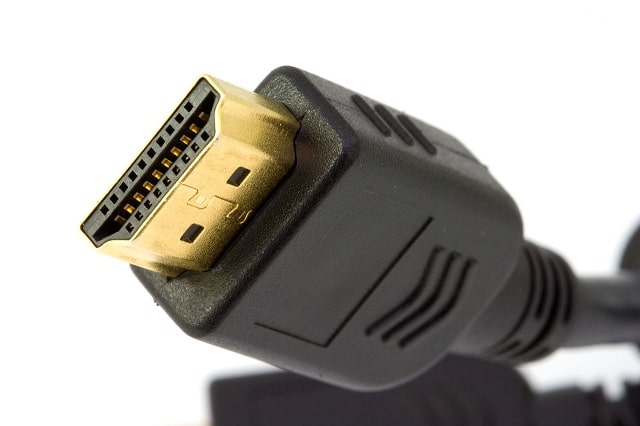You must not want to use a television whose video or audio fades in and out, but your tv doesn’t need to create the problem because your high-definition cable can also cause the issue. You are unable to live with a bad high-definition wire. Here are the 9 signs and symptoms of bad HDMI cable.
Have you remembered sitting on an old black and white television? Modern technology has become helpful in this case. People who use the home theater bandwagon get benefits from high-definition technology. It helps to make it simple to connect multiple devices. The rich sound and beautiful images depend on the wires, which becomes essential for the home theater system. But if a wire goes wrong, it can bring your complete home theater system to a screeching, or blurry, halt.
How do you identify the signs your HDMI cable has gone bad? First, if you face general problems, you should check the high-definition wire to correct any issues. The reason is that these ports are not overly tight. Besides, these cables might become loose through use.
Whether you encounter handshake problems, you can try these four solutions: re-sequencing the turn-on process, checking the selected input, checking video resolution, and checking software updates.
You can try these three solutions regarding HDR problems, including using high-speed wires, ensuring all devices support HDR, and checking the video resolution settings.
When it comes to HDMI-DVI issues, you can try these solutions, including— ensuring all devices support HDCP, checking for conversion problems, and calling technical support.
What is HDMI?
HDMI is the abbreviation of High-Definition Multimedia Interface. It has streamlined connectivity in a few methods, which are often underestimated. Moreover, the technology keeps evolving to fulfill an ever-changing industry’s requirements.
The 2.0 version is the most recent iteration available to people, and it is compatible with 4K technology through 12-bit color and resolutions up to 60 FPS. But the 2.1 version will go beyond it. Although it was announced in 2017, the 2.1 version still supports the emergence of 10K technology. In addition, it keeps expanding on 4K and 8K capabilities.
What Causes a HDMI Cable to Fail?
A high-definition connector comes with nineteen pins. Therefore, you might face problems if any pins or the individual lanes inside the wire become damaged. In addition, the pins can carry different details, including video, audio, clock information for syncing, and communications data.
How to Know a Faulty HDMI Cable?
Physical damage is one of the primary reasons for a connection as it can damage the connector or pinch the cable. Whether you use a device such as a desktop monitor connected constantly or disconnected from the laptop, you might face issues with the extra wear.
Several devices feature cheap pack-in wires. Unfortunately, these might not be similar to the quality of the third-party wire. If your wire is soldered poorly, it might fail even under little stress. Environmental factors such as changes in temperature or humidity can cause the problem.
If you are willing to protect your wires, you need to learn how you should do the wrapping and store them accurately. Generally, most wires coil in a particular direction. As a result, the cables can break or degrade like other technology devices or appliances. However, remember that a good-quality wire can never go bad.
Rough handling and age are the reasons why a wire can face issues. Pulling, bending, or stretching the wire can unplug a few cables; As a result, it can generate problems with signal transmission. In addition, water, heat, and dust might ruin the connectors.
Reasons for Cable Getting Spoilt:
An HDMI cable’s life expectancy depends from individual to individual. A like you use daily could be exposed to poor handling, stretching, or tension.
Suppose your work is included in heavy technology use. For instance, it might be sound engineering, wide-scale projecting, or film work. You should use these in such cases. We advise you to purchase some additional ones for an emergency. The primary reason for getting spoilt by a user is poor handling.
- If you fold wires, it can cause breakage of internal fibers.
- Dust can accumulate in the cable sockets.
- It might be exposed to excessive heat, water, or other liquids.
- Never break or bend the terminals inside the socket.
- Don’t store the wire poorly or use it carelessly, like putting heavy items on it or pulling it excessively.
Signs and Symptoms of Bad HDMI Cable:
Do you know how to check whether the HDMI cable is working or not? These are the most common signs and symptoms of a bad HDMI cable.
-
Fuzzy or No Picture:
You need to use a new wire if the video on your tv doesn’t work or appears fuzzy. In addition, another poor sign includes if the picture fades in and out, clips, or lags. You will find it irritating while watching your favorite show. Finally, you might need a new wire if anything happens to the TV.
-
The Colors Are Off:
The colors are off on display, which is an issue. Remember that Discoloration is the major problem because most people think something is wrong with the TV. But in this case, using a new high-definition wire can remove the symptoms of a bad 4k HDMI cable because it can transmit up to 4K.
-
Inconsistent Sound or No Sound at All:
Have you experienced your favorite show while the Sound goes out or starts fading in and out? These are the bad HDMI cable symptoms that need a replacement. However, remember that a few fewer faulty HDMI cable symptoms are available. Hence, you should check the connector of the wire. It interferes with your picture or audio and damages your tv. In addition, a faulty HDMI cable might interfere with your Internet connection as wires with Ethernet capabilities.
-
Sparkles:
Sparkles indicate “shooting stars,” representing white and multi-colored dots. These manifest on the display if the wire is at or slightly over its tolerance. It happens while you use a lower-gauge model to carry a signal 75 feet or more. But if a short wire causes sparkles, a stressed connector or pin inside the connector can be a reason, bent slightly or otherwise damaged. It is one of the major common signs and symptoms of a bad HDMI cable.
-
Lack of Control:
CEC or consumer electronics control enables High-definition multimedia interface-enabled components to communicate with one another. The option decreases the requirement for manual settings between sources, receivers, and televisions. It is because the devices will know about the capabilities of other devices after they are enabled. Whether you have turned on the option in the equipment, you can enable or disable all default devices. Hence, your job is to use the power button on the remote of one of those devices. The loss of control is one of the symptoms of the corresponding pin in the connector. Several other loose HDMI cable symptoms include an unexpected loss of picture or a CEC-controlled device closing unexpectedly.
-
Blank Screen:
You should enable a source device and a display to yield an image of some sort only while the wire functions correctly and you are on the appropriate input on your tv. Whether you continually see the black screen means you have encountered the issue. Hence, you should try to swap the wire and power off all devices. Then, you need to turn on them. It can help you to isolate the wire as the culprit.
-
Solarization:
It represents a phenomenon of the odd and ill-defined coloring of images. These generally sparkle throughout the display because the reason is similar. The phenomenon appears as a pink, blue, and light green tinge or border on things. If you use On-screen items with several colors blended into one, the flesh tones are the most obvious, while the wire is having issues. It is one of the symptoms of a bad 4k HDMI cable.
-
Inconsistency in Video Display:
Watching a video that stops, breaks, constantly, or contains screeches will not benefit you. A wire’s primary function is to transmit audio and video waves from output and input devices. Hence, you can use projectors, and AV receivers as output devices, while televisions, computers, and display monitors are perfect for I/O devices.
As soon as the tiny wires are fried or have shifted out of place, the line might encounter problems sending signals to your device. In this case, you should replace it to fix the problem.
-
No Response When Connected to AV Device:
If you plug in a cable, you will get an instant AV display for some monitors and display devices. However, you can get some alerts via Sound or terms like “HDMI connected” on display. Whether you have not seen the response, you should try to use a different wire to check if the broken item belongs to you.
Other Common HDMI Issues:
Nowadays, technology has been offering beautiful pictures and sounds flawless. But it doesn’t indicate that the problems will not pop up. If you know which is causing a problem, it can help you to fix the error.
A few of the most common bad HDMI cable symptoms PC include:
- No picture.
- Blurry or fuzzy picture.
- Discoloration.
- Intermittent picture.
- Poor resolution.
- Lack of Sound.
Sometimes, you should check your high-definition wire to ensure that you have inserted it into every connecting device to eliminate issues. Have you faced any frayed or exposed wires? If yes, then it can damage your wire. As a result, you need to replace it. Check the high-definition wire first to ensure it is fully connected to both devices. If you know this, it will help you to get rid of the majority of the fixable problems associated with a high-definition wire.
HDMI “Handshake” Issues:
HDCP stands for High Bandwidth Digital Content Protection and allows you to protect copyrighted material. Regarding 4K technology, it is referred to as HDCP 2.2. HDCP was invented by Intel Corporation, which can prevent clients from copying distributed media like movies, video games, and broadcasts. Blu-ray, etc.
If you want to use HDCP technology, you must use high-definition wires to work. Whether your high-definition connection is not secure or has become damaged, your home theater will suffer from this.
HDMI HDR Issues:
HDR is the abbreviation of High Dynamic Range. Beyond 4K technology, it can offer images subjected to a much more comprehensive color range. As a result, viewers will get much more information. The expanded color potential gives them a more extensive scale to depict even the smallest nuances. As the technology is new, all devices don’t support it. Some things are available that you can do if the HDR video feed is not coming through how clear you expect it to come.
HDMI DVI Issues:
DVI or Digital Visual Interface technology can predate high-definition multimedia interfaces. There are several old TVs and devices people are still using today. It can use DVI technology rather than HDMI. It only depends on video signals. Besides, Sound has to be relayed through either RCA or 3.5mm audio wires rather than that.
However, you can connect your device still to the DVI gadget through a conversion wire or a specially-made adapter. The primary problem is connected to older versus newer technology. A dodgy wire can cut out an image. As a result, you will not see any image at all being seen on display. You might encounter periodic “blackouts” in which the display goes black completely. After that, it makes a return again.
What Can You Do For Your Wireless High-Definition Multimedia Interface Issues?
It is called WHDI and WiHD, which is new but relies on the format. These help to decrease the wires required for the home theater. In addition, these are ideal for people with devices spaced far apart.
These have many issues. If you experience any problems with the wireless high-definition multimedia interface, you should try to move around it to prevent it. Line of sight and distance can cause the issue. If you find the devices moving around, but it does not help, you will need to take the help of tech support for your specific device.
Can a Bad high-definition Cable Damage the TV?
It can’t damage your television. But it might affect your usage. If you use a lousy wire, it will cause the videos to play poorly or inconsistently. But an active model carrying an electrical current can damage your tv. As a result, you see shooting stars, sparkles in the project on the display, lines, or an intermittent image in your display. Remember that you might find the visual interference disturbing if you are photo-light-sensitive. Active high-definition wires can pose a threat to the television. Active high-definition wires like the 1.4 version carry 3 volts. Others, such as the 2.0 version, transmit 5 volts.
Can It Affect Sound?
It can affect Sound because it will decrease the quality of the Sound transmitted to your AV device. As a result, you can see breakage in the Sound received or none. These transmit Sound and visual signals. Therefore, your wire is the culprit if your audio or screen is fuzzy, distorted, or skipping.
The Bottom Line:
High-definition multimedia interface cables last long. But a problem with them is that these can go bad eventually. The still wires can lose efficiency while handled roughly, folding tightly, or exposing them to dust, water, or hot temperatures. Never use a bad high-definition cable become it can cause sound and video transmission breakage. As a result, it becomes hard for you to enjoy using the device. You can interchange the wire, but it is possible to expand the life of the cable.
Frequently Asked Questions:
- How often do these cables go bad?
These don’t go bad over time; you have to replace them one day.
- Do these cables wear out?
These can wear out damage from heavy use, coiling, and bending.
- Can it damage the TV?
It can not cause damage. But, generally, it will cause “sparkles.”







